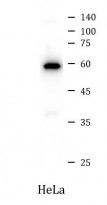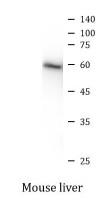ARG57998
anti-SLC7A11 / xCT antibody
anti-SLC7A11 / xCT antibody for Immunoprecipitation,Western blot and Human,Mouse,Rat
Ferroptosis/Oxytosis Study antibody

Overview
| Product Description | Rabbit Polyclonal antibody recognizes SLC7A11 / xCT |
|---|---|
| Tested Reactivity | Hu, Ms, Rat |
| Tested Application | IP, WB |
| Host | Rabbit |
| Clonality | Polyclonal |
| Isotype | IgG |
| Target Name | SLC7A11 / xCT |
| Antigen Species | Human |
| Immunogen | Synthetic peptide derived from Human SLC7A11 / xCT. |
| Conjugation | Un-conjugated |
| Alternate Names | xCT; CCBR1; Cystine/glutamate transporter; Solute carrier family 7 member 11; Amino acid transport system xc-; Calcium channel blocker resistance protein CCBR1 |
Application Instructions
| Application Suggestion |
|
||||||
|---|---|---|---|---|---|---|---|
| Application Note | Note: Based on the reference PMID: 35322867 This antibody may also suitable for ICC/IF application in human samples. * The dilutions indicate recommended starting dilutions and the optimal dilutions or concentrations should be determined by the scientist. |
||||||
| Observed Size | ~ 60 kDa |
Properties
| Form | Liquid |
|---|---|
| Purification | Affinity purified. |
| Buffer | PBS (pH 7.4), 150mM NaCl, 0.02% Sodium azide and 50% Glycerol. |
| Preservative | 0.02% Sodium azide |
| Stabilizer | 50% Glycerol |
| Storage Instruction | For continuous use, store undiluted antibody at 2-8°C for up to a week. For long-term storage, aliquot and store at -20°C. Storage in frost free freezers is not recommended. Avoid repeated freeze/thaw cycles. Suggest spin the vial prior to opening. The antibody solution should be gently mixed before use. |
| Note | For laboratory research only, not for drug, diagnostic or other use. |
Bioinformation
| Database Links | |
|---|---|
| Gene Symbol | SLC7A11 |
| Gene Full Name | solute carrier family 7 (anionic amino acid transporter light chain, xc- system), member 11 |
| Background | This gene encodes a member of a heteromeric, sodium-independent, anionic amino acid transport system that is highly specific for cysteine and glutamate. In this system, designated Xc(-), the anionic form of cysteine is transported in exchange for glutamate. This protein has been identified as the predominant mediator of Kaposi sarcoma-associated herpesvirus fusion and entry permissiveness into cells. Also, increased expression of this gene in primary gliomas (compared to normal brain tissue) was associated with increased glutamate secretion via the XCT channels, resulting in neuronal cell death. [provided by RefSeq, Sep 2011] |
| Function | Sodium-independent, high-affinity exchange of anionic amino acids with high specificity for anionic form of cystine and glutamate. [UniProt] |
| Highlight | Related news: Ferroptosis/Oxytosis Antibody Panel is launched; Therapeutic strategies against PDAC; Disulfidptosis markers; Related Antibody Duos and Panels: ARG30337 Ferroptosis / Oxytosis Antibody Panel Related products: SLC7A11 antibodies; SLC7A11 Duos / Panels; Anti-Rabbit IgG secondary antibodies; |
| Research Area | Ferroptosis/Oxytosis Study antibody |
| Calculated MW | 55 kDa |
Images (4) Click the Picture to Zoom In
-
ARG57998 anti-SLC7A11 / xCT antibody WB image
Western blot: Mouse Testis stained with ARG57998 anti-SLC7A11 / xCT antibody at 1:1000 dilution.
From Lipeng Li et al. Ecotoxicol Environ Saf (2023), doi: 10.1016/j.ecoenv.2023.115309, Fig. 2F1.
-
ARG57998 anti-SLC7A11 / xCT antibody WB image
Western blot: 20 μg of HeLa cell lysate stained with ARG57998 anti-SLC7A11 / xCT antibody at 1:1000 dilution.
-
ARG57998 anti-SLC7A11 / xCT antibody WB image
Western blot: 20 μg of Mouse liver lysate stained with ARG57998 anti-SLC7A11 / xCT antibody at 1:1000 dilution.
-
ARG57998 anti-SLC7A11 / xCT antibody WB image
Western blot: GBC-SD cells stained with ARG57998 anti-SLC7A11 / xCT antibody.
From Desen Fan et al. Heliyon (2024), doi: 10.1016/j.heliyon.2024.e30260, Fig. 2. E.
Customer's Feedback
Specific References



 Good
Good

 Excellent
Excellent







